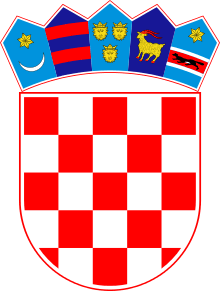Battle of Slankamen
The Battle of Slankamen was fought near Slankamen in the Ottoman Sanjak of Syrmia (modern-day Vojvodina region, Serbia) on August 19, 1691, between the Ottoman Empire, and the Imperial Army, the personal forces of the Holy Roman Emperor, together with the Reichsarmee of the Holy Roman Empire of the German Nation and Austrian-Hungarian-Croatian-Serbian combined forces under the command of Louis William, Margrave of Baden-Baden, as part of the Great Turkish War.
| Battle of Slankamen | |||||||
|---|---|---|---|---|---|---|---|
| Part of Great Turkish War | |||||||
 Illustration of the battle in the Theatrum Europaeum (1702). | |||||||
| |||||||
| Belligerents | |||||||
|
| Ottoman Empire | ||||||
| Commanders and leaders | |||||||
|
| Köprülüzade Fazıl Mustafa Pasha † | ||||||
| Strength | |||||||
|
| ||||||
| Casualties and losses | |||||||
| 7,300[2] | 25,000[1] | ||||||
%2C_1677_-_1707%2C_Medal_1691%2C_Victory_against_Turkey%2C_obverse.jpg)
%2C_1677_-_1707%2C_Medal_1691%2C_Victory_against_Turkey%2C_reverse.jpg)
Background
The Ottomans had suffered partial military collapse against the Archduchy of Austria in the 1680s, most notably at the Battle of Vienna in 1683, and the loss of Belgrade to Maximilian II of Bavaria in 1688 and Bosnia in 1689. However, with the beginning of the Nine Years War in the west, the early 1690s were to see an end to Habsburg conquests in the Balkans and a partial Ottoman recovery.[3] Many German troops were withdrawn from the east to fight King Louis' French forces on the Rhine, encouraging the Ottomans, led by the Grand Vizier Köprülü Fazıl Mustafa Pasha, to continue the war. The Ottomans managed to retake Belgrade and most of present-day Serbia.
In August 1691, Louis William, Margrave of Baden-Baden had been able to gather an army of 50,000 and marched south to provoke the Ottomans into another major battle, similar to the Battle of Mohács (1687), after which all the lost territory could be retaken.
Battle
The clash between the two forces took place on the west side of the Danube, opposite the outlet of the Tisa. Both armies deployed near Zemun, but the superior Ottoman army at first didn't attack for two days. Then Baden-Baden tried to provoke the attack, by withdrawing slowly to a fortified position near Slankamen. The Ottomans followed and surrounded the Imperial Army. By August 19, the heat, disease and desertion had reduced both armies to 33,000 and 50,000 able men. On that day the Ottoman cavalry finally attacked.
These were unorganized charges, however; although huge, the Ottoman forces were poorly armed and no match for the firepower of Louis of Baden's German-Austrian infantry and field guns. Additionally, the Ottomans' supply system was incapable of waging a long war on the empty expanses of the Pannonian plain.[3] Initially the Ottomans were at an advantage, as they advanced and burned 800 supply wagons of the Imperial Army. Louis of Baden, in a desperate situation, broke out of his position, besieged by the Ottomans, and turned their flanks with his cavalry, inflicting fearful carnage.[4] After a hard battle, the 33,000-man Imperial Army was victorious over the larger Ottoman force. The death of Grand Vizier Köprülü Fazıl Mustafa Pasha during mid-battle caused the Ottoman morale to drop and the army to disperse and retreat.
Legacy
A 16-metre-tall obelisk (52 ft) was built in Slankamen to commemorate the victory of the Imperial Army.[5]
Notes
- Christian Greiner: Der „Türkenlouis“ – Markgraf Ludwig von Baden-Baden (1655–1707), in: Militärgeschichtliche Beiträge, Bd. 3, Herford/ Bonn 1989, pp. 27–41.
- Max von Turek: s.v. Szlankamen, in: Bernhard von Poten: Handbuch der gesamten Militärwissenschaften, Bd. 9, Leipzig 1880, p. 106
- McKay & Scott. The Rise of the Great Powers 1648–1815, p. 75
- Chandler. A Guide to the Battlefields of Europe, p.374
- Damjanovic, Dragan. "Javni spomenici, radovi zagrebačkih arhitekata, u Kupinovu, Novom Slankamenu i Vezircu kod Petrovaradina ( Public Monuments Built by Architects from Zagreb in Kupinovo, Novi Slankamen, and Vezirac near Petrovaradin )". Scrinia Slavonica : godišnjak Podružnice za povijest Slavonije, Srijema i Baranje Hrvatskog instituta za povijest, Nr. 10, pages 226-243.
References
- David Chandler. The Art of Warfare in the Age of Marlborough. Spellmount Limited, (1990). ISBN 0-946771-42-1
- David Chandler. A Guide to the Battlefields of Europe. Wordsworth Editions Ltd, (1998). ISBN 1-85326-694-9
- Derek McKay and H.M. Scott. The Rise of the Great Powers 1648–1815. Longman, (1984). ISBN 0-582-48554-1
- Christian Greiner: Der „Türkenlouis“ – Markgraf Ludwig von Baden-Baden (1655–1707). In: Militärgeschichtliche Beiträge. Bd. 3, 1989, ISSN 0936-3564, pp. 27–41.
- Jason Goodwin; The Ottoman Wars
| Wikimedia Commons has media related to Battle of Slankamen. |


